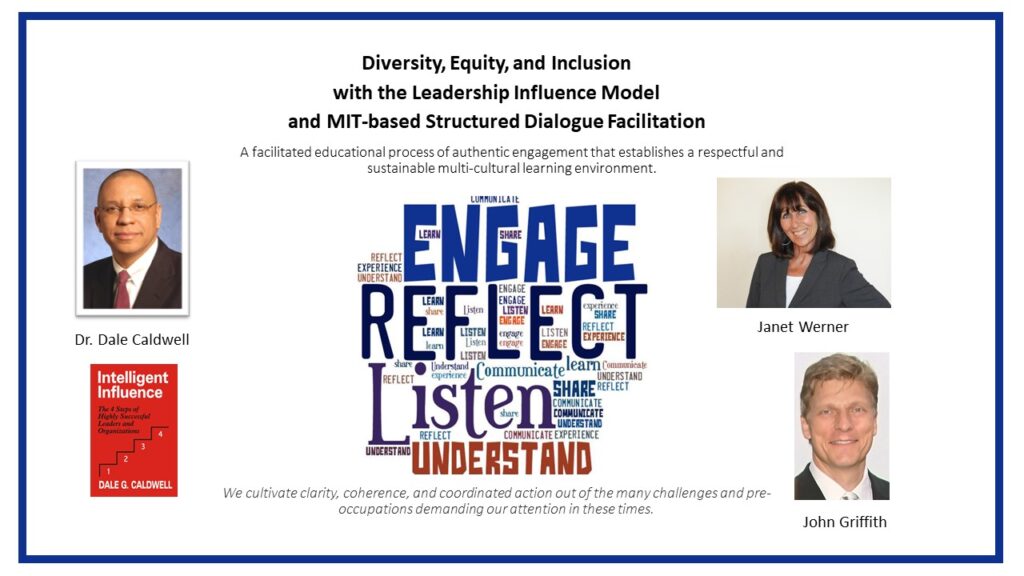Thousands of corporate executives & employees engaged in applying the disciplines of DIALOGUE in the 1990’s during our Rethinking How We Think business consulting projects. Now we are applying these tools to Rethinking Mental Health in a way that influences the business of mental health systems transformation.

A flock of birds suddenly taking flight from a tree reveals the potential of coordinated action that can come from dialogue: this is movement all at once, a wholeness and listening together that permits individual differentiation but is still highly interconnected. W. Isaacs

Structured DIALOGUE Assumption Checking disciplines were introduced to the business world in the 1990’s through the MIT Dialogue Project & Peter Senge’s Fifth Discipline Fieldbook.

Clients printed poster sized Assumption Checking placemats for their work desk as reminders.
We applied the tool of DIALOGUE with thousands of corporate executives and employees during large scale change leadership initiatives, strategic planning, interdepartmental team process improvement, employee engagement and most recently in the tough conversations around race relations.


Director of HR, Organon Pharmaceuticals gave Janet his book from seminary training in the 1960s following the training of HR senior team in MIT-based DIALOGUE.
We begin by facilitating a sequence of 3 zoom meetings on your business agenda to demonstrate results of achieving clarity, coherence & coordinated action.
Storytelling is a popular topic for these dialogues especially in race relations & reconciliation.
We use Table Talk Tools™ to make it easier for teams at work, at home, at school & in the community to engage in conversations and storytelling. The MIT-based structured dialogue discipline provides participants with the language and framework to share with discernment and authenticity and listen more attentively while learning to integrate wisdom from each other.
Experience-based pilot programs are available for:
- Business Table Talk Storytelling
- Family Table Talk Storytelling
What you will notice as structured DIALOGUE is applied:
- Employees are engaged quickly and set up for sustainability.
- Meetings are more efficient with action steps that require less follow up.
- Teams align more quickly on the same page.
- Participants see the interconnected bigger picture and streamline work processes.
- Listening and understanding increased.
- Curious inquiry prompts new solutions to old recurring problems.
- Conflict is resolved with less effort.
- Assumption checking language is applied in every day interactions minimizing emotional blocks & expediting forward movement.
Sample Day 1 Agenda 1.5hr – 2hr zoom
- Introduction to DIALOGUE disciplines from MIT
- Dialogue practice: What are our current challenges & concerns?
- Discussion: What are our shared priorities now?
- Dialogue practice: What are our assumptions around these priorities & challenges? How limiting are these assumptions? What new assumptions might we consider?
- Discussion: What new solutions might we apply from these new assumptions?
- Dialogue practice: What if we applied these new solutions? How might that improve our efficacy and business results? What might it look like, sound like & feel like to be successful at implementing these solutions? How urgent are we?
- Closing: What are our agreements to move forward? Who is doing what by when?
- Schedule next team zoom dialogue and 1-1 coaching in between sessions.
DIALOGUE best practices that drive results in less time include:
- Apply assumption checking language from our Business Table Talk™ placemat.
- Use the STOP Pause time out moment in meetings from our Business Table Talk™ placemat.
- Practice the language:
- I’m wondering…
- What if…
- How might we…
Structured DIALOGUE disciplines are best applied over a period of 3-6 months in order to fully establish the competencies within the culture and realize the greater business impact.
In true DIALOGUE even though it feels slow in the beginning we actually move through and past all the conflict and misperceptions at the beginning and we become far more efficient by focusing on the priorities and then move on to action steps that we agree on. Dialogue before discussion keeps us from getting lost in the muck. Susan
What will it be like as we STOP getting lost in the muck?
Clients who have experienced the benefits from
DIALOGUE training & facilitation:
“Communication was poor. Trust level was low. After a few meetings DIALOGUE disciplines opened the lines of communication and allowed sincerity to come through into new actions.” Director, Manufacturing. Hoffmann La-Roche
“Something seems to ‘click’ for individual participants and at times the entire team when an intense dialogue is facilitated at the end of a meeting to bring all the points together.” Jennifer Van Zandt, President Bullseye Sales.
“Dialogue seems like it slows down the progress but at some point it all comes together and we “pop” into ahha…clarity.” United Chemical Workers Union.
“I found a smoother flow in the discussion that followed dialogue. I already felt listened to so there was no need to fight for airtime.”
MIT-based DIALOGUE disciplines are based on the same roots as the OPEN DIALOGUE framework from Finland applied to mental health crisis care. A Finnish Remedy to Mental Health Crisis Shows Promise | Psychology Today 2023

We train & certify the HR partner, leadership team member or business owner in Dialogue Mastery Facilitation to establish the competency within the organization that continuously produces results in business meeting applications.
Our team applies Structured Dialogue Facilitation to Race Relations & Reconciliation.

